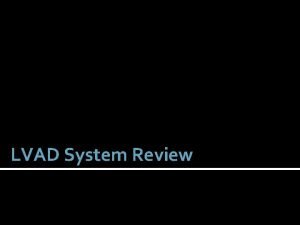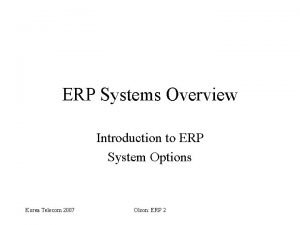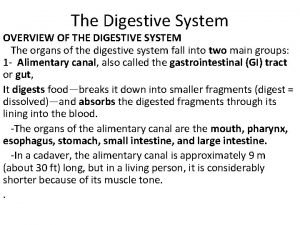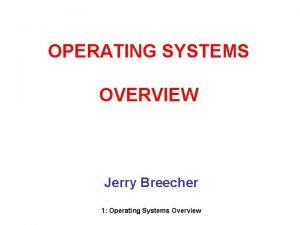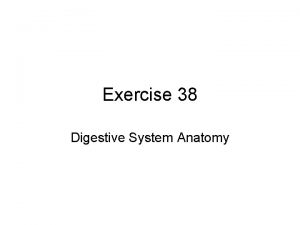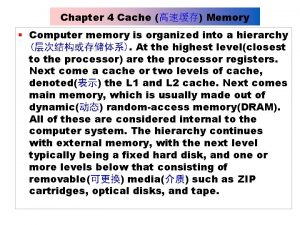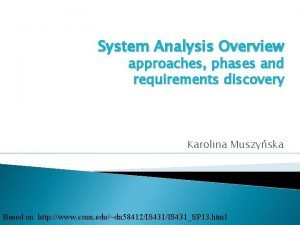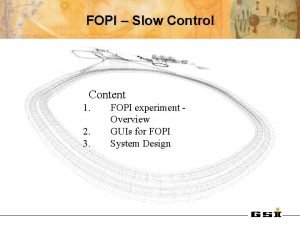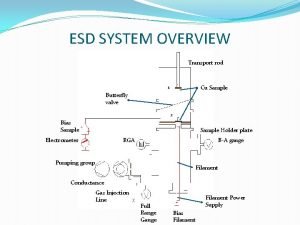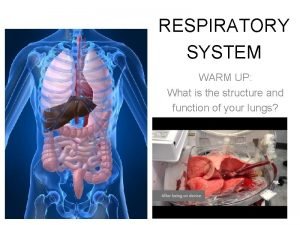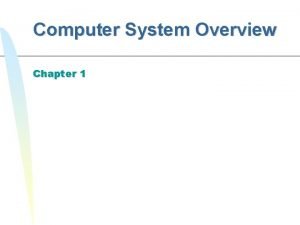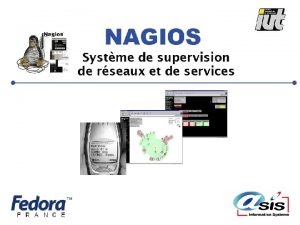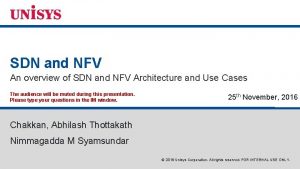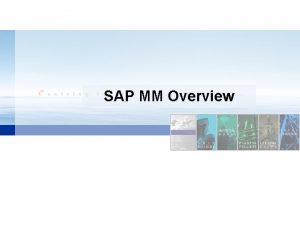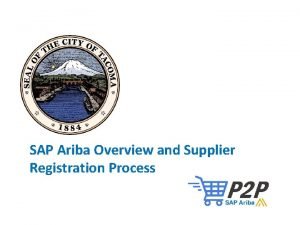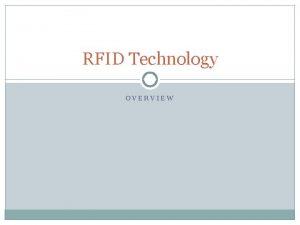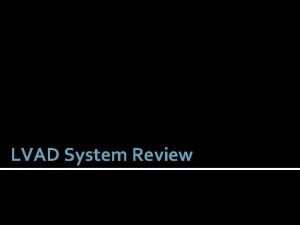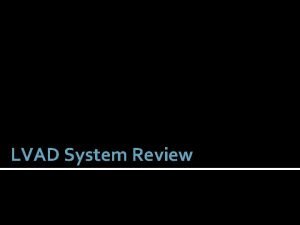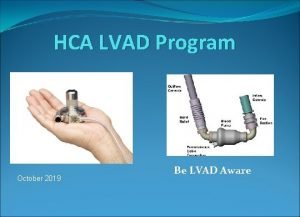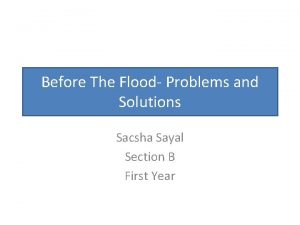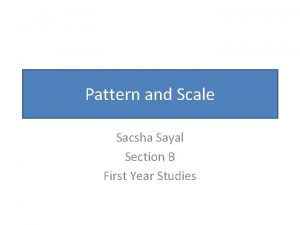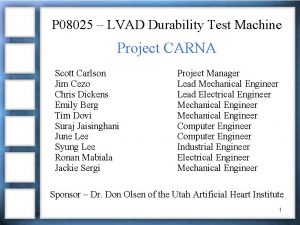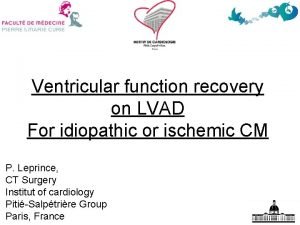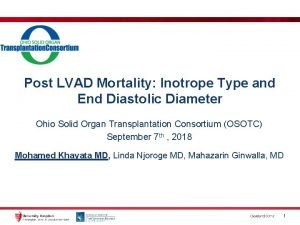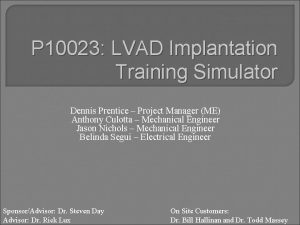LVAD System Review System Overview Smiha Sayal System















































- Slides: 47

LVAD System Review

System Overview Smiha Sayal

System Overview �Left Ventricular Assist Device (LVAD) Mechanical device that helps pump blood from the heart to the rest of the body. �Implanted in patients with heart diseases or poor heart function.

System Goal �Miniaturize the existing LVAD system to achieve portability while retaining its safety and reliability.

Original System �“Black box” architecture used during development �Large, not portable �Runs on AC power

P 10021’s System �Has both internal / external components �Equivalent to our “Option 2” �Unfinished implementation

Customer Needs �Safe �Robust �Affordable �Easy to wear and use �Interactive with user �Controllable by skilled technician �Comparable performance �Compatible with existing pump

Other LVAD Technologies Cor. Aide (NASA)

Other LVAD Technologies

Concepts: Option 1 All electronics external

Concepts: Option 2 ADC internal only

Concepts: Option 3 Pump and motor control internal

Concepts: Option 4 All electronics and battery internal

Concept Generation

Concept Generation Highlights Option 1 • • Bes t O ptio n Smallest internal volume Feasible within timeline Easiest to maintain Minimum 20 wires Option 2 • Relatively small internal volume • Slightly higher risk of internal failure • Minimum 10 wires 350 273 Option 4 • • Large internal volume Difficult to design Electronics failure is fatal Minimum 3 wires 200 Large internal volume Difficult to design Electronics failure is fatal Minimum 3 wires 153

Enclosure Design Nicole Varble and Jason Walzer

Material and Processing Selection � � Needs The external package should be lightweight/ robust/ water resistant The devices should be competitive with current devices The device should fit into a small pouch and be comfortable for user Specification • Based on the Heart. Mate II � � – Optimum weight of 4 lbs – Optimum volume of 56 in 3 Risks Housing for the electronics is too heavy/large/uncomfortable Preventative measures Eliminate heavy weight materials Eliminate weak, flexible materials Material is ideally machinable

Concept Generation. Materials/Manufacturing Process Manufacturing Processes Rapid Prototyping (ABS Stereolithography Injection Molded Machine Metal or Polymer Plastic) Selection Criteria Weight Rating Notes Score Cost 9 4 36 3 27 1 $30 k for mold 9 2 18 Feasibility within timeline 10 5 50 4 long lead time 40 1 10 3 30 Strength 6 4 37 MPa 24 5 58 MPa 30 5 35 -70 MPa 30 5 ~580 MPa 30 Material Interaction with water 4 2 8 4 resin based 16 5 20 4 16 Ease of Manufacturing 3 5 15 3 9 0 0 20 wires 0 10 wires 0 3 wires 0 Net Score 133 128 78 103 Rank 1 2 3 4 Continue? no no

Water Resistant Testing • • Need: The external package should resist minor splashing Specification: Water Ingress Tests – – – • • Once model is constructed, (user interface, connectors sealed, lid in place) exclude internal electronics and perform test Monitor flow rate (length of time and volume) of water Asses the quality to which water is prevented from entering case Risk: Water can enter the external package and harm the electronics Preventative measures: – – – Spray on Rubberizd Coating Spray on Silicon Guard Spray on Rubber Coating or adhesive O-rings around each screw well and around the lid Loctite at connectors http: //scoutparts. com/products/? view=product&product_id=14074 Urethane Plastic Spray-On Coat http: //safetycentral. com/watspraysilw. html http: //www. smooth-on. com/Spray-Materials-St/c 1281_1287/index. html? catdepth=1

Robustness Testing � � Need: The device should survive a fall from the hip Specification: Drop Test � � � Drop external housing 3 -5 times from hip height, device should remain fully intact Specify and build internal electrical components Identify the “most venerable” electrical component(s) which may be susceptible to breaking upon a drop Mimic those components using comparable (but inexpensive and replaceable) electrical components Goal Show the housing will not fail Show electronics package will not fail, when subjected to multiple drop tests The housing fails before the electronic components in drop tests The electronic components can not survive multiple drop tests Eliminate snap hinges from housing (screw wells to secure lid) Test the housing first Take careful consideration when developing a thickness of the geometry Design a compact electronics package Risks Preventative Measures

Heat Dissipation to the Body Need • • Internal Enclosure must dissipate a safe amount of heat to the body Risk • • Internal electronics emit unsafe amounts of heat to body causing tissue necrosis Benchmarking • – Series of tests studied constant • • power density heat sources related to artificial hearts – 60 -m. W sources altered surface temperatures 4. 5, 3. 4, 1. 8 °C above normal at 2, 4, 7 weeks – Internal devices must not increase surrounding tissue by more than 2°C Specifications 40 m. W/cm 2 (source increased to upper limit of 1. 8 °C) Wolf, Patrick D. "Thermal Considerations for the Design of an Implanted Cortical Brain–Machine Interface (BMI). " Ncib. gov. National Center for Biotechnology Information, 2008. Web. 30 Sept. 2010. <http: //www. ncbi. nlm. nih. gov/bookshelf/br. fcgi? book=frimp∂=ch 3>.

Ergonomics Need: Device should be comfortable for user • ANSUR Database • – Exhaustive military database • • outlining body dimensions Waist Circumference (114) – Males: 137. 3 mm – Females: 126. 0 mm Waist Depth (115) – Males: 113. 1 mm – Females: 102 mm Calculated average radius of hip – Males: 125. 2 mm – Females: 114. 0 mm Acceptable Avg. Radius of hip – ~120 mm

Rapid Prototyping • • • Machinable – Material can be drilled (carefully) and tapped Accepts CAD drawings – Obscure geometries can be created easily – Ideal for proposed ergonomic shape Builds with support layer – Models can be built with working/moving hinges without having to worry about pins • Capable of building thin geometries • Stereolithography • • UV curable polymer resin Creates a non-porous solid • Enclosure will be waterproof and not require additional coating • • Lightweight – Specific gravity of 1. 17 • ABSplus Dimension System – Industrial thermoplastic • • Lightweight - Specific gravity of 1. 04 Porous – Does not address water resistant need http: //www. dimensionprinting. com/

ABS Plastic Mechanical Property Test Method Imperial Metric Tensile Strength ASTM D 638 5, 300 psi 37 MPa Tensile Modulus ASTM D 638 330, 000 psi 2, 320 MPa Tensile Elongation ASTM D 638 3% 3% Heat Deflection ASTM D 648 204°F 96°C Glass Transition DMA (SSYS) 226°F 108°C Specific Gravity ASTM D 792 1. 04 Coefficient of Thermal Expansion ASTM E 831 4. 90 E-5 in/in/F • Important Notes • Relatively high tensile strength • Glass Transition well above body temperature • Specific Gravity indicates lightweight material

Enclosure Concept �CAD model is can be easily resized �Removable top panel for electronics access

Embedded Control System Andrew Hoag and Zack Shivers

Control System �Requirements Selecting suitable embedded control system Designing port of control logic to embedded system architecture �Customer Needs Device is compatible with current LVAD Device is portable/small Allows debug access

Impeller Levitation � Impeller must be levitating or “floating” � Electromagnets control force exerted on impeller � Keeps impeller stabilized in the center � Position error measured by Hall Effect sensors

Levitation Algorithm �Algorithm complexity influences microcontroller choice Electronics choices affect volume / weight �Proportional – Integral – Derivative (PID) Very common, low complexity control scheme http: //en. wikipedia. org/wiki/PID_controller

Embedded System Selection � Requirements: Can handle PID calculations Has at least 8 x 12 -bit ADC for sensors at 2000 samples/sec Multiple PWM outputs to motor controller(s) Same control logic as current LVAD system Reprogrammable

Embedded System Selection � Custom Embedded ds. PIC Microcontroller ▪ Blocks for Simulink ▪ Small ▪ Inexpensive (<$10 a piece) TI MSP 430 ▪ Inexpensive (<$8 a piece) ▪ Small, low power � COTS Embedded National Instruments Embedded ▪ Uses Lab. VIEW ▪ Manufacturer of current test and data acquisition system in “Big Black Box” ▪ Large to very large ▪ Very expensive (>$2000)

Control Logic/Software � Closed-loop feedback control using PID – currently modeled in Simulink for use with the in “Big Black Box” � Additional microcontroller -specific software will be required to configure and use A/D, interrupts, timers.

Life Critical System �Not at subsystem level detail yet. �Life-critical operations would run on main microcontroller. �User-interface operations run on separate microcontroller. �Possible LRU (Least Replaceable Unit) scheme

Separation of Main/UI Microcontroller Concept Selection

Technician/Field Software Debug Interface � USB � Serial (RS-232) USB is everywhere. Requires custom PC-side software. Requires processor support. Many computers don’t have serial ports anymore. ▪ Can use $15 COTS USB to Serial adapter. Can use COTS terminal tools.

Technician/Field Software Debug Interface �Example of using COTS tool – Windows Hyper. Terminal (free/part of Windows)

Technician/Field Software Debug Interface Concept Selection

Microcontroller Search Parameters �A/D 0 -5 V 8 x 12 -bit @5 ksps (kilo-samples/sec) ▪ This equates to 40 ksps minimum for A/D �PWM �General I/O for UI controls At least 10 x digital At least 5 x analog �UART (for Serial connection)

Microcontroller Packaging �L/TQFP – Low-profile/Thin Quad Flat Pack Small surface-mount (PCB mount) chip package. Is solderable (by skilled solderer) Body thickness up to 1. 0 mm, sizes range from 5 x 5 mm to 20 x 20 mm

Microcontroller � 2 families of Microcontrollers ds. PIC from Microchip MSP 430 from Texas Instruments

Microchip ds. PIC �ds. PIC 30 F 5011 (16 -bit architecture) Max CPU speed 30 MIPS (Million Instructions/sec) 2. 5 -5. 5 V operating voltage 66 KB Flash, 4 KB RAM, 1 KB EEPROM 16 x 12 -bit ADC @ 200 ksps -40 to 85 C operating temp 64 -lead TQFP – body 10 x 10 mm, overall 12 x 12 mm Cost [1 -25 units] = $7. 21

TI MSP 430 �MSP 430 F 5435 A (16 -bit architecture) Max CPU speed 25 MIPS (Million Instructions/sec) 2. 2 -3. 6 V operating voltage 192 KB Flash, 16 KB RAM 16 x 12 -bit ADC @ 200 ksps 3 Timer modules (with total of 15 timer channels) -40 to 85 C operating temp 80 -lead LQFP – body 10 x 10 mm, overall 12 x 12 mm

Microcontroller Concept Selection

Next Steps Juan Jackson

Tasks �Battery analysis �Motor controller research and selection �Enclosure final design �Further microcontroller analysis �Embedded code �Cost analysis

Timeline Tasks Analyze Battery Needs Hot Swapping Choose Connectors Decide Voltage Find Back up Battery Choose Battery Controller Choose Power Regulator Design PCB Research Motor Controller Choose Amplier Redesign RC Filter Define Ideal Curvature Define Material and Processes 11 th - 17 th M T W R F S Create Open CAD Drawing Define External Coating Priliminary CAD drawing Helical thread insert Spec out O rings Layout User Interface Control Law Pseudocode Select Microcontroller Generate SDD Addition components Bill of Materials Cost Analysis System Design Review Time to Finish 18 th - 24 th 25 th - 31 st S M T W R F S S M T 1 st - 7 th W R F S

Questions / Comments Help us improve our design!
 Sayal usb
Sayal usb Aseem sayal
Aseem sayal Chapter review motion part a vocabulary review answer key
Chapter review motion part a vocabulary review answer key Uncontrollable spending ap gov
Uncontrollable spending ap gov Narrative review vs systematic review
Narrative review vs systematic review Inclusion criteria examples
Inclusion criteria examples Narrative review vs systematic review
Narrative review vs systematic review Sap erp system overview
Sap erp system overview Introduction to content management system
Introduction to content management system Conclusion of computerized accounting system
Conclusion of computerized accounting system Ductus parotideus
Ductus parotideus Sap ps
Sap ps Operating systems overview
Operating systems overview Sequence diagram for gym management system
Sequence diagram for gym management system Exercise 38 anatomy of the digestive system
Exercise 38 anatomy of the digestive system Set associative mapping in cache memory
Set associative mapping in cache memory Computer memory system overview
Computer memory system overview British school system
British school system Financial intermediaries
Financial intermediaries British school system overview
British school system overview System analysis
System analysis System design overview
System design overview System overview sample
System overview sample Solar system overview
Solar system overview 3 lobes of lungs
3 lobes of lungs Computer system overview
Computer system overview Www overview
Www overview Maximo overview
Maximo overview Uml overview
Uml overview Uml
Uml Vertical retailer
Vertical retailer Figure 12-1 provides an overview of the lymphatic vessels
Figure 12-1 provides an overview of the lymphatic vessels Systemic artery
Systemic artery Texas recapture districts
Texas recapture districts Walmart inventory management systems
Walmart inventory management systems Stylistic overview of architecture
Stylistic overview of architecture Sa/sd methodology
Sa/sd methodology Spring framework overview
Spring framework overview Nagios tactical overview
Nagios tactical overview Market overview managed file transfer solutions
Market overview managed file transfer solutions Sdn vs nfv
Sdn vs nfv Sbic program
Sbic program Sap mm consignment process
Sap mm consignment process Sap ariba overview
Sap ariba overview Safe overview
Safe overview Rfid technology overview
Rfid technology overview Sots meaning in research
Sots meaning in research Virusmax
Virusmax
